|
| Book Transcription |
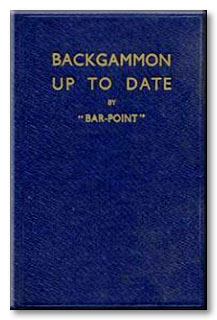
|

|


Introduction
It has been left to the present generation to revivify and bring back, with perhaps little alteration, the game that occupied the attention of their grandparents, and, although constantly practised by a few aware of its subtle charm even up to the present day, alas it has been forgotten by the many.
Backgammon indeed dates back much farther than a mere couple of generations. It is on record that tables similar to Backgammon have been found in the Tomb of Tutankhamen, and in fact a similar game was indulged in by the Kings of Egypt and Ur of the Chaldees.
Historians tell us the Roman Legionaries used to play “on the tables,” we imagine, much as our Tommies spent a few leisure hours playing Crown and Anchor, Housey, Housey, and similar games.
It is well known as an ancient game in Japan and India, and, as Tric Trac, has been played for centuries in most European countries. The modern Backgammon may not be the leisurely game indulged in by our forebears. Its essentials, however, remain similar. The present-day mode of existence demands a game with some zest, some real thrill — and some snap in it. In modern Backgammon we find a first-class game not only for two persons but a game in which a number can join. Backgammon provides a game both quick and fast in which one must exercise skill, judgment, alertness and foresight. Yet it is not a game which quickly palls or requires profound concentration as in Chess or even Bridge or Contract. As such it appeals to the youth of to-day.
The introduction of the doubling system and the gambling element has done a great deal to re-popularise Backgammon, and the new Chouette has made it a popular pastime which has long been looked for by Hostesses all over the country. It is no wonder that, where it is increasingly difficult to get a “four” for Bridge, Backgammon tables are always constantly filled.
Equipment
Backgammon is played with draughtsmen and dice on a specially marked and spaced table or board.
The board itself is divided into four tables, each consisting of six points coloured alternately in two contrasting colours. (See Diagram I.)
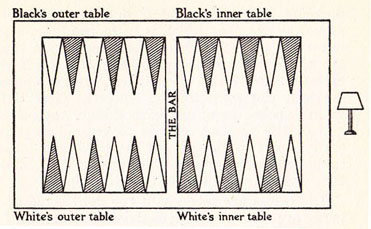
| Diagram I. |
Assuming light is on right. Showing the four tables divided by the bar. Note:
|
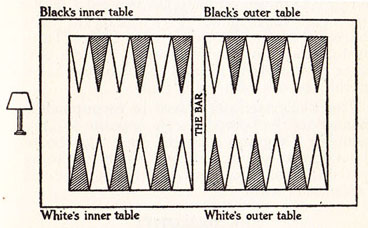
| Diagram II. |
| Note: When light is on left, the left-hand tables are the inner tables. This is optional although some players observe the ruling strictly. Players should accustom themselves to both settings. |
The Board is divided by a centre partition, known as the bar, which separates the inner and outer tables. The whole board is surrounded with a raised side to prevent the dice and men from falling from the tables. To obtain the best game choose a table or board of ample or large proportions. With a small board it is extremely difficult to get a comprehensive survey of the positions of the men at a glance.
The playing surface should be of leather, cork or similar substance so that the men move easily and quickly, and the dice are comparatively noiseless, and do not irritate the players as when thrown on a wooden surface.
The men are thirty in number, fifteen of one colour for one player and fifteen of a contrasting colour for his opponent.
For the purposes of this book they will be referred to as Black and White.
The dice are the usual six-sided dice numbered on the faces one to six, and although it is quite in order for two dice only to be used alternately by each player, two dice each person is now more usual.
Large dice with clearly marked pips are to be preferred and the corners may be square cut or rounded.
The dice cups or shakers, one for each player, are of good size and must be large enough for the two dice to turn over easily. They may be cylindrical or waisted and constructed of wood or leather. If the former they are preferable felt lined to obviate noise and rattle.
The men or pieces can be of wood, ivory, ivorine, mother of pearl, or any hard substance, and must be chosen in relation to the board on which it is proposed to use them. They must be neither too large so as not to fit, or too small so that the player is uncertain of their exact position. If six men fit snugly into one of the tables there can be no question that they are of the correct dimensions.
The modern and up-to-date Backgammon demands a doubling cube, or doublock, as it is sometimes called. This has the appearance of a dice of gigantic proportions. It is made of ivory, ivorine, wood or other substance and is numbered 2, 4, 8, 16, 32, and 64, one number on each of its six sides. The cube is placed on the table at one side and keeps the players informed at all times of the position of the stakes. (See Doubling.)
Lay-Out or Set-Up of Board
It has been explained in the section of this book devoted to equipment that the table or board is divided into four tables. Each player has an inner and outer table. The players sit opposite each other and it must be predetermined before play which is to be the inner and outer tables. It is agreed in some circles that the tables nearest the light are always the inner tables, although this is purely a matter of choice between the participating players. The Diagram I shows the tables marked inner and outer, and it will be observed the players sit next to their own two tables and each player’s inner table is directly opposite his opponent’s. Similarly the outer tables are directly opposite.
The tables are reversed if the light should be in the opposite direction as shown in Diagram II and players should accustom themselves to both settings. Each player controls fifteen men of one colour, and the men are placed on the points as illustrated in Diagram III, namely: White — Two men on the point marked 1 in the opponent’s inner table. Five men on the point marked 6 in the opponent’s outer table. Three men on the point marked 2 in the player’s own outer table and five men on the point marked 6 in the player’s own inner table.
The Black men are placed in corresponding manner on the points exactly opposite White’s men, see Diagrams III and IV. The board is not numbered in actual use, the numerals being placed in the diagrams for the purposes of explanation only.
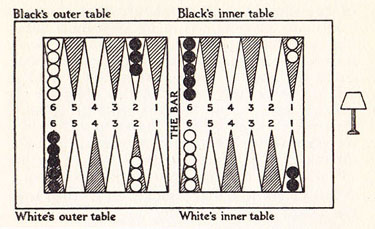
| Diagram III. |
| Note: Numbers do not appear on the actual board, but are placed on the diagram for purposes of reference only. Points marked 1 in the inner tables are known as the ace points. Points marked 1 in the outer tables are known as the bar points. |

| Diagram IV. |
| Light on left, therefore inner tables on left. Numbers do not appear on actual board but are placed on the diagram for purposes of reference only. Points marked 1 in the inner tables are known as the ace points. Points marked 1 in the outer tables are known as the bar points. |
The Objective
The object in Backgammon is for each player to move his men in accordance with the throws of the dice in such a manner that they are eventually congregated in his own inner table, and to remove them entirely from the board also in accordance with the throws of the dice. From a glance at the Diagrams I I I and IV it will be seen that to obtain this objective the players have to move their men in opposite directions. Whilst Black moves in a clockwise direction White has to move in an anti-clockwise direction. The reverse is the case in Diagram IV, where the light is in the opposite position.
The player who first removes all his men from the board wins the game.
Opponents men may be stopped and sent back in certain circumstances. This naturally opens up a good deal of possibilities which are explained at some length in the section of this book devoted to the move of the men.
The Throw of the Dice
The dice are thrown into the table at the player’s right hand.
To commence the game each player throws one dice, the highest thrower becoming entitled to make the first move. Should both players throw the same number they must throw again.
Some players elect that the highest thrower should play taking his own and his opponent’s throw as the first move. Others allow the highest thrower another throw with his own pair of dice for the opening move.
After the opening move the players throw their two dice alternately and make their moves in accordance with the numbers thrown until the game is terminated.
The Move of the Men
It is the player’s aim to move his men into his own inner table, once there to have them removed from the board entirely. It will be observed from the proceeding diagrams some of the player’s men have the whole distance to travel whilst others are already advanced some way towards their goal. From a glance at Diagrams III and IV it will be noticed that a player has to take some of his men through both his opponent’s inner and outer table and then through his own outer table to reach his inner or home table, which is his final objective.
The men are moved a corresponding number of points according to the numbers turned up by the two dice thrown by the player. Any man may be moved to commence the game and the player has the choice of moving his men in two different ways.
A player may not add the numbers of the two dice together and then play the total as one move. He may, however, play the same man twice, first in accordance with the number thrown on one dice and, second, in accordance with the number thrown on the other dice. He may move two separate and distinct men, one man according to one dice and a second man according to the other dice. The point on which the man rests does not count in the move. That is to say, the move commences on the point next to the one on which the man rests that it is intended to move. It will be found of use when playing to remember a move of even number takes the man from a point of one colour to a point of a similar colour, and conversely a move of an uneven number takes the man from a point of one colour to a point of a different colour. During the progress of a game a player may place an unlimited number of his own men on any one point provided that the point is not already occupied by two or more of his adversary’s men. A point is said to be “made” or “blocked” if it has two or more men upon it and an opponent cannot place his men upon a point so occupied.
A man may not be played on to an opponent’s blocked point as in the case of both numbers being played by one man. In this instance the numbers must be played separately so that each or either number will allow the man to rest on a point that is: —
- Unoccupied;
- Occupied by the player’s own man or men;
- Occupied by an opponent’s single man or Blot.
It is permissible to pass a blocked point provided the number to be played carries the man to either of the three positions above.
If like numbers are thrown by the two dice it is termed a doublet and double the number of moves are taken, viz.: Two threes thrown allow the player to effect four moves of three, either by the same man or by four different men or other method, provided always the move does not bring the man to a blocked point. Should it not be possible to play either one or both dice so as to bring a man on to a free point the player must lose either one or both points as the case may be.
Instances arise where it is impossible to play both dice, but by playing one dice first the player is enabled to play the other. At one time this method was frowned upon by good Backgammon players, but now is considered to be perfectly good play.
Any single man left or placed upon a point is termed a “blot” and may be removed by an opponent throwing a number which brings his own man on the point occupied by the blot.
A man thus removed is said to be “hit” or “taken up” and is placed upon the bar separating the tables. A player having a man or men upon the bar is not allowed to play another move until this man or men are re-entered.
A man that has been hit or taken up must be re-entered in the opponent’s inner table according to the throw of the dice.
Should the point on the board corresponding to the number shown on either of the two dice be blocked the man cannot be entered and the throw is lost to the player. If both points are unoccupied or occupied by his own men he may re-enter and choose either point upon which so to do, playing the other number with the same man or elsewhere.
Should the player have two or more men upon the bar he can only play those numbers which allow the men to be re-entered, losing the other numbers until all the men are re-entered. A man on the bar may be re-entered on an adversary’s blot if the number thrown corresponds with the point in the opponent’s inner table upon which the blot rests. The player both enters and takes up his opponent’s man at one and the same time. It is generally to the player’s advantage to take up the opponent’s blots where possible as their re-entering and starting again retards the opponent’s progress.
It will be recognised it is a distinct advantage to “make” as many points as possible in one inner table before hitting and taking up one’s opponent, as the more points that are so occupied make it increasingly difficult for the opponent to re-enter.
Bearing Off
As soon as a player has been able to move all his men into his own inner or home table he has to commence “bearing” or “throwing off,” which is to remove them entirely from the board.
This manoeuvre is effected in accordance with the throw of the two dice. A man is removed corresponding to the numbers turned up on the two dice. For example: should a six and a one be thrown a man from both the one-point (or ace, as it is sometimes called) and six-point may be removed, and so on. (See Diagram V.)
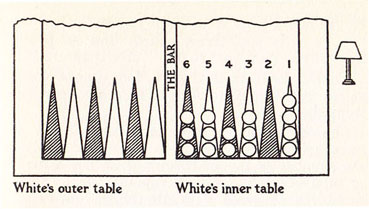
| Diagram V. |
| White has all his men in his own inner table and now commences to “bear off” according to the dice thrown. |
Should doublets be thrown, four numbers are called as previously and four men are removed from the board.
Should the player throw a number which is unoccupied by his men he is compelled to play the number of moves thrown if he has a man or men occupying a higher point, viz.: Supposing in Diagram V White throws four twos. He has nothing on point two to remove. He would have to move two men from point 4 to point 2, and then remove them (as doublets have been thrown, and he is entitled to four moves). He could, if he so desired, play two men from point 6 to point 4, and the same men thence on to point 2, moving the men instead of bearing them off. This would, of course, be unwise if his opponent had a man upon the bar, as a blot would be left, which in all probability Black would “hit” at the next throw.
It is not compulsory to remove men at each throw when bearing off has commenced. Instead a player may make the corresponding number of moves if he prefers, and indeed in certain instances a move is to be preferred. (See Diagram VI.)
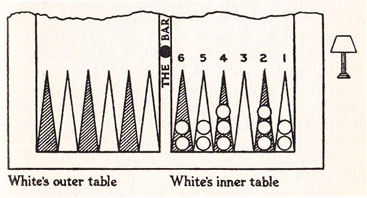
| Diagram VI. |
| White has commenced “bearing off” and has already removed three men. Black has a man on the bar which has to be re-entered in White’s home table. White throws six and one. If a man is removed from point 6 and point 1 a blot is left on both these points which it is possible for Black to hit on re-entering. White should remove a man from point 6 and play the remaining man one move from point 6 to point 5. |
Black has a man on the bar. White has already started bearing off and has, besides other men, two men on point 6. He throws a six and a one. If he removes a man from point 6 and a man from point 1, he leaves a blot on each of these points. It is politic to remove the man on point 6 and play the remaining man on this point one move to point 5, thus removing the danger of leaving a blot to be hit in all possibility by Black’s man at the next throw. Incidentally, by so doing White has given Black the chance to enter on point 6, which, however, is a good move, as should Black throw a six he must enter. Travelling in the opposite direction to White, however, he is now unable to attack any of White’s men. White is, therefore, safe to continue bearing off without fear of being hit by Black and can leave blots ad lib. if he so desires.
During bearing off, a blot taken up by an adversary has to be re-entered in the usual manner in the opponent’s inner table and bearing off ceases until this man or men have travelled round the board and have again been entered in the player’s own inner table. During the process of bearing off should a player throw a number higher than any point upon which he has a man or men he is allowed to bear off a man or men from the next highest point.
The player first to bear off all his men wins the game.
Doubling and Use of Doubling Cube or Doublock
It is the modern idea of doubling which has done so much to revive interest in Backgammon and put into it that new zest which makes it to-day so universally popular.
When throwing for first move and players are using one dice each, it happens on innumerable occasions that like numbers are thrown. This constitutes what is to-day termed an automatic double. That is to say, the resultant stake or value of the game is now double that which was originally arranged. A further throw of the dice must be made and it is possible for a doublet to again be thrown. In this event, the value of the game is considered to be once more doubled, and thus if the original stake was agreed as one unit at the present stage of the game it would be represented as four units. It so happens that these automatic doubles may recur somewhat indefinitely, and it is left to the players to decide beforehand to limit the number of automatic doubles to obviate prolific scores.
After the game has once started either player may double the original agreed stake. This must be done before he throws his dice and after his opponent’s move. The opponent may accept or decline the double as he wishes. Should he decline, the stakes as they stand at that time are surrendered and a new game commenced. Should the opponent accept the double, the game proceeds, the acceptor only, however, having the right to redouble the game in a similar manner. Should he redouble at a later stage, and his double be accepted, this gives the original doubler the right to once again offer a double. The right to double and redouble continues alternately between the two players. It will be seen therefore that the original stake may be doubled, redoubled and redoubled again and again indefinitely, although in actual practice it is very rarely that stakes are redoubled more than three or four times. It must be quite clear that a player once he has doubled cannot redouble until his opponent has himself doubled. This doubling and redoubling may at first seem exceedingly complicated.
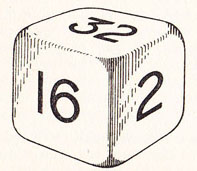
Doubling cube or doublock.
The introduction, however, of the doubling cube or doublock simplifies matters to a very marked degree. The doublock is the tell-tale which is placed on the table and informs the players the exact state of the game and the ultimate stake. As explained in the section dealing with equipment, the doubling cube is six-sided, and is numbered 2, 4, 8, 16, 32, 64. At the beginning of the game it is placed on the table surround with the number 64 face uppermost. With the first double, either automatic or optional, it is turned to 2 and changed to 4 and 8, and so on with succeeding doubles.
It is generally placed in front of the player having the right to the next double.
At the close of a game, or at any intermediate point, the player can see from the doublock how many times the original stake has been doubled and his liability at that time.
The doubling cube has now come into universal use and obviates the old-fashioned and muddling system of matches.
Scoring
The accepted methods of scoring are three in number, namely, scoring by Games, scoring by men, and scoring by both men and games. If scoring by games the result may be a single game, a Gammon or a Backgammon, which requires explanation. The score for a Single Game is the original stake agreed upon which may have been doubled and redoubled, and which would be multiplied by the number shown on the doubling cube at the close of the game.
A Gammon, or winning a game by removing all the men before the opponent has succeeded in removing any men at all. The score in this case is double the score of a single game, and this figure may also have been doubled and redoubled during the progress of the game, as has already been explained.
A Backgammon, or winning a game by removing all the men before the opponent has succeeded in removing any men and having left in one’s own inner table or upon the bar a man or men belonging to the opponent. In this instance the resultant score is multiplied by three. This score also can again be doubled and redoubled according to the various doubles offered and accepted during the game.
Scoring by Men. — The winner receives one point for each man the loser has remaining in the loser’s own inner table. The winner receives two points for each man the loser has remaining in the loser’s outer table. The winner receives three points for each man the loser has remaining in the winner’s outer table, and four points for each man the loser has in the winner’s own inner table or upon the bar.
If scoring by men the result may be doubled and redoubled by multiplying by the number shown on the doubling cube, but further doubling for Gammons and Backgammons are not counted.
Scoring by the Combination of Game and Men. — In this case the two previous systems of scoring are combined and results in a system of scoring by men whereby the result is doubled for a Gammon and multiplied by three for a Backgammon.
The Rules of Backgammon
There is not at the moment any recognised authority to lay down definite and standard rules for Backgammon, although there have been handed down through the ages in which the game has been played certain decisions which are now generally acknowledged by players of the modern game. They may be accepted as rulings which control the game and are for its good.
Rules Controlling Dice
Backgammon may be played with —
- One dice box and two dice, each player throwing alternately therewith.
- Two dice boxes and four dice, each player throwing alternately with his own dice box and two dice.
The dice must be thrown in the table on the player’s right.
It is not a fair throw, and both dice must be re-thrown if —
- Either dice fails to remain in the correct table, either jumping on the bar, the surround, into the next table, or falling from the board altogether.
- If a dice does not lie flat on the board, either remaining on top of or cocked one against the other, or lying cocked against edge of the bar or surround of the board or table.
- A player throws his dice before his opponent has finished his move.
No penalty is incurred for the re-throw, and the player does not lose his turn.
To determine who shall play first each player throws a single dice.
The player throwing the highest number has the right to play first. He may also elect to choose which men and upon which tables he will play.
It is optional for the first player to make his first move using the two single dice thrown or re-throw his own pair of dice.
When single dice are being thrown to determine the right to play first and like numbers are thrown the stake for which the game is being played is automatically doubled. If on the re-throw like numbers are thrown again the stakes are once more doubled. This automatic doubling may at the outset of the game be either entirely dispensed with or limited to a certain number by agreement between the opposing players.
The numbers on both dice must be played if possible and either may be played first.
Rules Controlling Moves
Men are moved a number of points in accordance with the numbers of pips on the two dice thrown by the player. The point on which the man rests does not count in the move. The move starts from the point next to that on which the man rests. A single man resting on a point may be taken up or removed by an opponent throwing a number which brings him on to the same point.
A man so taken up is placed on the bar and must be re-entered in the opponent’s home or inner table, according to the numbers on the dice thrown. A point occupied by two or more men is “made” and an opponent cannot place his men thereon.
Any number of a player’s own men may be placed upon a single point. If a single man is left in the inner table an opponent may re-enter and take up at one and the same time. No rectification of errors in moving is allowed if discovered after the opponent has made his throw.
Automatic Doubling
The agreed stake is automatically doubled if both players throw like dice when throwing single dice for first play.
A limit for automatic doubling may be agreed upon before play.
Doubling
Either player may call the first double.
After the first call the right to double alternates, the player last accepting having the right to redouble.
Doubles are called after one’s opponent has moved, and before the player’s own dice are thrown.
A double not accepted terminates the game, the player refusing the double forfeiting the value of the stake at the time of termination.
Initial Moves, Etc.
Having gained a general idea of the layout of the board and the method of propulsion and the move of the men, the intending player should make a point of becoming familiar with the board and the various moves that can be made upon it.
Practice both methods of setting up or laying out the board with the light on the right and also on the left (See Diagrams III and IV), so that it is not necessary to rely upon a Diagram for this operation. A good deal of groundwork and practice can be accomplished to make the initiate accustomed to the board and positions if several try-out games are played by himself only, operating alternately his own and opponent’s men. In this manner it will bring home to the player the folly of any unwise move, and in addition he will perceive the rapidity with which an opponent will readily seize the opportunity of any mistake and convert it to his own use and account. Moreover, after several games of this nature the eye will have become attuned to the board and layout and more or less instinctively will grasp the possibilities of attack and defence. Remember, that the throw of an even number will bring your man on to a point of a similar colour to that upon which it rests, and an odd number will bring it to a point of a different colour. Do not forget, also, that a throw of a six will move a man from one corner of a table to the first point of the adjoining table, and a five will fetch a man from one corner of a table to the other corner.
See to it that you fix the move in your mind and convey the man quickly and decisively to the requisite point. Do not count the move out aloud or tap it with the edge of the man in transit. Not only may this damage the board, but it is not considered good play.
There has been no definite or authoritative law governing initial or opening moves, and indeed there can be none.
Each player uses his own skill, judgment, and perception to determine what in his mind is the best move for the two numbers turned up for him by Dame Fortune for the opening move.
At the same time there has descended from time immemorial a number of moves which are now regarded as classic or stock moves for opening throws. In an endeavour to make these clear to the novitiate, a series of diagrams has been prepared, and a note describing the move appended to each in the following pages.

| Diagram VII. |
| Double Six. — White has played double six. White moves two men from point marked 1 in Black’s inner to point 1 in Black’s outer table, and two men from point marked 6 in Black’s outer to point 1 in White’s own outer table. |

| Diagram VIII. |
| Double Five. — White has played double five. White moves two men from point 6 in Black’s outer table to point 2 in White’s outer, and thence on to point 3 in White’s own inner table. |
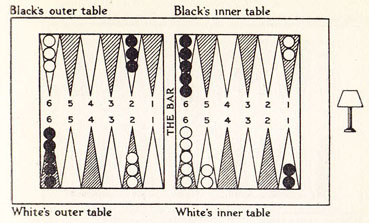
| Diagram IX. |
|
Double Four. — White has played double four. White moves two men from point 6 in Black’s outer to point 3 in White’s outer, thence to point 5 in White’s own inner.
Alternative Move. — White moves two men from point 1 in Black’s inner to point 5 in same table, and two men from point 6 in Black’s outer to point 3 in White’s own outer table. |

| Diagram X. |
|
Double Three. — White has played double three. White moves two men from point 6 in Black’s outer table to point 4 in White’s outer, and thence on to point 1 in same table, making the bar point.
Alternative Move. — White moves two men from point 2 in own outer table to point 5 in own inner table, and two men from point 6 in own inner to point 3 same table. |
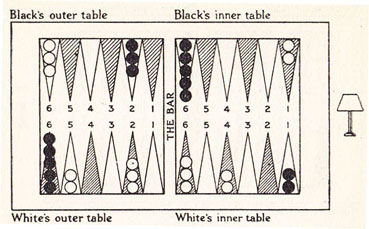
| Diagram XI. |
|
Double Two. — White has played double two. White moves two men from point 6 in Black’s outer to point 5 in White’s outer table, and two men from point 6 in White’s inner to point 4 in same table.
Alternative Move. — White moves two men from point 1 in Black’s inner table to point 3 same table and on to point 5 same table. |
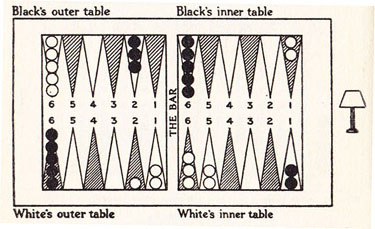
| Diagram XII. |
| Double One. — White has played double one. White moves two men from point 2 in White’s own outer table to point 1 same table, and two men from point 6 in White’s own inner table to point 5 same table. |
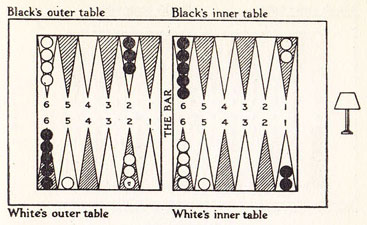
| Diagram XIII. |
| Two and One. — White has played two and one. White moves one man from point 6 in Black’s outer table to point 5 in White’s own outer table, and one man from point 6 White’s own inner to point 5 same table. |
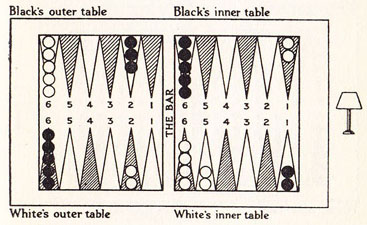
| Diagram XIV. |
| Three and One. — White has played three and one. White moves one man from point 2, White’s own outer table, to point 5 White’s own inner table, and one man from point 6, White’s own inner, to point 5 same table. |
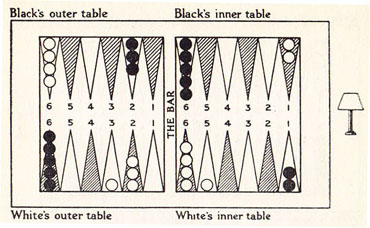
| Diagram XV. |
|
Four and One. — White has played four and one. White moves one man from point 6, Black’s outer table, to point 4 in White’s own outer table, and one man from point 6 in White’s own inner to point 5 in same table.
Alternative Move. — White moves one man from point 1, Black’s inner table, to point 2 same table, and one man from point 6, Black’s outer table, to point 3, White’s own outer table. |
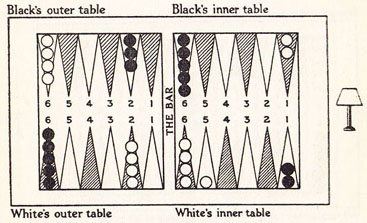
| Diagram XVI. |
| Five and One. — White has played five and one. White moves one man from point 6 in Black’s outer table to point 2 in White’s own outer table, and one man from point 6 in White’s own inner to point 5 in same table. |
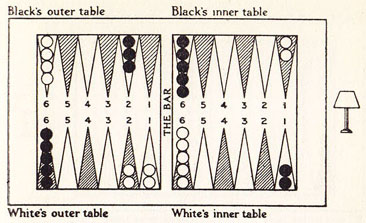
| Diagram XVII. |
| Six and One. — White has played six and one. White moves one man from point 6 in Black’s outer table to point 1 in White’s own outer table, and one man from point 2 in White’s own outer to point 1 in same table. |
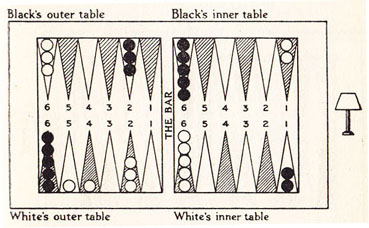
| Diagram XVIII. |
|
Three and Two. — White has played three and two. White moves one man from point 6 in Black’s outer table to point 4 in White’s own outer table, and another man from point 6 in Black’s outer table to point 5 in White’s own outer table.
Alternative Move. — White moves one man from point 6 in Black’s outer table to point 5 in White’s own outer table, and one man from point 2 in White’s own outer table to point 5 in White’s own inner table. |

| Diagram XIX. |
| Four and Two. — White has played four and two. White moves one man from point 2 in his own outer table to point 4 in his own inner table, and one man from point 6 in his own inner table to point 4 same table. |
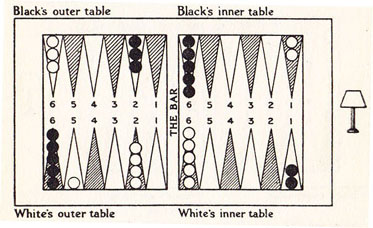
| Diagram XX. |
| Five and Two. — White has played five and two. White moves one man from point 6 in Black’s outer table to point 2 in White’s own outer table, and another man from point 6 in Black’s outer table to point 5 in White’s own outer table. |

| Diagram XXI. |
|
Six and Two. — White has played six and two. White moves one man from point 6 in Black’s outer table to point 1 White’s own outer table, and thence on to point 5 in White’s own inner table.
Alternative Move. — White moves one man from point 1 in Black’s inner table to point 1 Black’s outer table, and thence on to point 3 Black’s outer table. |

| Diagram XXII. |
|
Four and Three. — White has played four and three. White moves one man from point 6 in Black’s outer table to point 3 White’s own outer table, and another man from point 6, Black’s outer table, to point 4 in White’s own outer table.
Alternative Move. — White moves one man from point 6 in Black’s outer table to point 3 in White’s own outer table, and one man from point 2 in White’s own outer table to point 5 in White’s own inner table. |
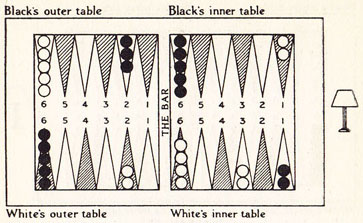
| Diagram XXIII. |
| Five and Three. — White has played five and three. White plays one man from point 2 in White’s own outer table to point 3 in White’s own inner table, and one man from point 6 in White’s own inner table to point 3 same table. |
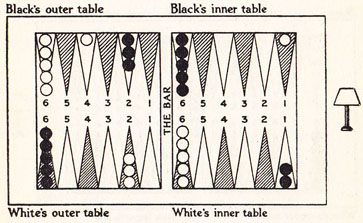
| Diagram XXIV. |
|
Six and Three. — White has played six and three. White moves one man from point 1 in Black’s inner table to point 1 in Black’s outer table, and thence to point 4 in Black’s outer table.
Alternative Move. — White moves one man from point 6 in Black’s outer table to point 1 White’s own outer table, and another man from point 6 in Black’s outer table to point 4 in White’s own outer table. |
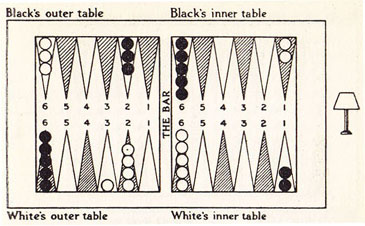
| Diagram XXV. |
|
Five and Four. — White has played five and four. White moves one man from point 6 in Black’s outer table to point 2 in White’s own outer table, and another man from point 6 Black’s outer table to point 3 in White’s own outer table.
Alternative Move. — White moves one man from point 1, Black’s inner table, to point 5 same table, and thence on to point 4 in Black’s outer table. |
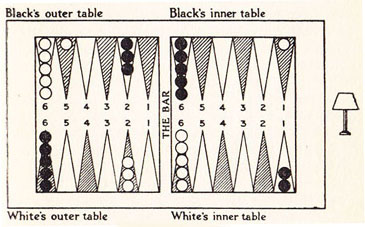
| Diagram XXVI. |
|
Six and Four. — White has played six and four. White moves one man from point 1 in Black’s inner table to point 1 in Black’s outer table, and thence to point 5 in Black’s outer table.
Alternative Move. — White moves one man from point 2 in White’s own outer table to point 2 in White’s own inner table, and one man from point 6, White’s own inner table, to point 2 same table. This is not recommended, as it carries White’s men too far forward to be of much service later in the game. |
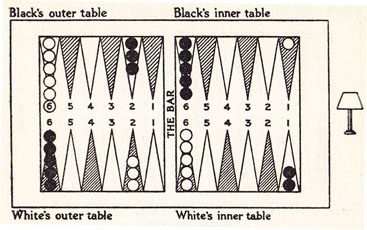
| Diagram XXVII. |
| Six and Five. — White has played six and five. White moves one man from point 1 in Black’s inner table to point 1 in Black’s outer table, and thence on to point 6 in Black’s outer table. This is known as the “lover’s leap.” |
Chouette
In addition to the introduction of the doubling system the fact that the new Backgammon allows three, four, five, or any reasonable number of people to participate, has done much to renew its popularity. This modern form, or Chouette as it is called, permits one player to play alone against a number of opponents. To commence Chouette each intending participant throws a single dice.
The player throwing the highest number is deemed to be “in the box,” and plays against the remaining players. The player throwing the next highest number takes his place at the table and with the remaining players opposes the man in the box. Whilst the thrower of the second highest number actually plays and controls the men himself he is assisted by the other players, who are at liberty to advise him on any strategic move or point out any impending attack threatened by the men belonging to the man in the box. The inactive players whilst assisting in this manner can give advice on doubling, etc., but the actual double can only be offered by the player moving the men. Should the man in the box win the game he collects the stake, doubled or redoubled as the case may be, from each member of the opposing side, and conversely should the game be lost by the man in the box he has to pay the amount of the stake to each of the opposing team.
If the man in the box wins, his opponent’s place is taken by the player originally throwing the third highest number and the man in the box again plays all the members of the opposing team as previously. Should, however, the man in the box lose in the first game his place is taken by the player inflicting his defeat, and he joins the team to oppose the new man in the box.
The original man in the box places himself last on the list of players to oppose the new man in the box. The game proceeds in this manner until one of the players succeeds in inflicting defeat on the man in the box and takes his place as previously. Another point which has done much to popularize Chouette is that additional persons may at the close of a game join the team, or members of the team. May drop out if they desire. Any person joining the team places himself at the bottom of the list of players to oppose the man in the box.
The opposing player at the table, whilst accepting advice, retains the final right on all questions of play, and should any difference of opinion arise between players in the team the opposing player’s decision must be regarded as final. A member of the team is allowed to resign if he disagrees with his playing partner, but in so doing has to pay to him the amount of the stake doubled or redoubled as it might be at the moment of retirement. The playing member of the team is then deemed to have accepted the retiring member’s responsibility and the game proceeds.
Automatic doubling is not applicable when players throw to ascertain who shall become first man in the box. At the commencement also it happens at times that like numbers are thrown. If this occurs amongst the highest numbers thrown all players must re-throw. In the case of like numbers being thrown in the lower numbers, only those players throwing like numbers need re-throw to determine their own position in the team.
The players originally throwing the high numbers retain their positions as man in the box, his opponent, and so on.
It may appear at first sight as if the man in the box runs a grave risking of losing a small fortune, and some players might hesitate to participate in Chouette in consequence.
It must be remembered, however, that the first time he is beaten he relinquishes his position as man in the box, and does not run the further risk of a similar happening.
On the other hand, if he inflicts a series of defeats on the opposing team he will be in the fortunate position of receiving stakes from each and all of the participating players.
Technique
The average player of Backgammon will soon perceive for himself that there can be, and indeed there is, certain methods of play which can be utilised to advantage to secure first, the quicker entering of the player’s men into his own inner table, and, secondly, to secure the blocking or preventing of the opponent reaching his goal or final objective. There have been evolved three methods which are now generally known as the Running Game, the Blocking Game, and the Back Game, which will be enlarged upon in the order named in the following pages.
The Running Game
This method of play, as its name implies, consists of a straightforward policy of getting the men home to the inner table in the shortest time possible. It is by far the easiest and simplest of all three strategies and is usually adopted when large numbers are first thrown with the dice. It has been explained in the previous sections of this book that when big numbers like double-six and six-five are thrown it is wisest for the player to play the two men he has on the first point in his opponent’s inner table. These are, incidentally, the men who have the farthest distance to travel.
He has then succeeded in making these men immune from attack in his opponent’s inner table and has gained no little advantage over his opponent thereby. Should big numbers still continue to be thrown there is no question that the Running Game is the soundest tactics to employ, and the player should use every endeavour to get his men round the board by the quickest methods possible. Whilst playing this type of game it is well to remember that the opponent may endeavour to frustrate the rapid entry of your men by purposely exposing blots. It should be borne in mind that if these blots are taken up the opponents will have to re-enter in the player’s inner table and on re-entering may possibly take up some of the men the player has already worked the whole distance around the board. Avoid, therefore, as much as possible the taking of enemy blots whilst playing the Running Game.
It is always advantageous to move a man from one table into the next table, if at all possible, rather than to move a man from one point to another in the same table.
It is rarely possible to get a Gammon or Backgammon when playing this Running Game as, leaving no definite defence to hamper one’s adversary and avoiding the taking up of his men, he has almost as good a chance of getting his men home as the player himself, especially if he be favoured with good and large-numbered dice. The first and initial large throws which prompted the player to adopt the Running Game should, however, usually be sufficient margin to allow him to win the game.
The Blocking Game and Shutout
Another method of play, the Blocking Game, consists of the player placing his men in such a position as to block, impede and prevent his adversary from getting his men out from the player’s inner or home tables.
To successfully accomplish this task the player must endeavour to make the points on either side of the bar in his own inner and outer tables, and so frustrate his opponent’s attempts to escape. It is possible to get six consecutive points blocked at one and the same time, and this constitutes what is known as a “Side Prime.” Once a Side Prime is established it is a perfect blockade, and, as the highest number on the dice is six, it is impossible for the opponent to pass this formidable obstacle. The player should move up his other men as quickly as possible and endeavour to carry his Side Prime into his own inner table where the opponent’s two men are imprisoned until the player has to break his formation during the process of bearing off.
What might perhaps be termed an offshoot of the Blocking Game is the “Shut out.” This is in fact a Side Prime established in the player’s inner or home table with one or more of the opponent’s men on the bar.
It is best attempted when the opponent’s two men in the player’s inner table are split up, and are on different points. The opponent’s men are taken up and the points made at the same time, the player endeavouring to hit the opponent’s blot and make the point at each re-entry, and so establish a Side Prime within his own inner table with his adversary on the bar. Great care should be exercised in bearing off from a shutout. It is policy to move up men from the six-point rather than remove men altogether whilst the opponent is on the bar. This opens up the six-point and provides the opponent with an opportunity to re-enter which he must do if in the next throw he turns up a six. It will be seen that this removes the danger of attack from the opponent who is moving in the opposite direction. Some experienced players, however, will risk only bearing off their men in an attempt to secure a Gammon or Backgammon Game.
The Back Game
There can be no question whatever that the Back Game is by far the most difficult game to play. A player winning a Back Game can only at the best win a single game, whereas, should he lose a Back Game, he stands to lose a double game at least.
Whilst the novice at Backgammon may find himself unwittingly playing a forward or running game and even may quite unconsciously find himself developing a Side Prime or Shutout, by having the good fortune to throw perfect numbers with his dice, it is rarely, if ever, that a Back Game is entered upon unintentionally.
The object in the Back Game is entirely opposite to that of the Running Game. In the latter the player endeavours to push his men forward as much as possible, whilst in the former it is his intention to keep them back and retard their progress. The tactics employed in the Back Game are for the player to obtain a good position in his opponent’s inner table by laying out a number of intentional blots to be taken up by his opponent, and with these men to hamper as much as he can the entry of the opponent into his home or inner table. To successfully adopt this procedure he must space out his men so that they have every opportunity of meeting as many of the opponent’s men as possible.
If the player’s men are already too far advanced it would be unwise to attempt the Back Game. One of the biggest difficulties which besets the player of this type of game is his inability to keep his men far enough behind.
When the player has spread his blots or single men and had them re-entered in his opponent’s inner table he should endeavour to push a few more blots forward in his opponent’s and his own outer tables and to use these to recapture any men which he has been able to take in his opponent’s inner table. It is thus that he can keep his opponent out and gradually work up his own men to a blockade and eventually, maybe, a Shutout to the mortification of his opponent, who has possibly thought himself secure in getting a good number of his own men forward in the opening stages of the game, and had delighted in taking up the unsuspecting blots which had been purposely set as a trap for him. A Back Game is usually entered upon when the player finds himself throwing indifferent dice and considers he is unable to make any definite progress, whilst his opponent appears to be making the most of the game. It is undoubtedly the most strategic of all the methods of play and should be practised assiduously in order to assimilate its many fine characteristics without a knowledge of which a Back Game could not be played to a successful conclusion.
Definition of Terms in Backgammon
| A Blot |
A single man left upon a point. |
| Automatic Double |
When throwing for first play using one dice only and each player throws a like number, the original stake is automatically doubled. |
| Backgammon |
When a player has succeeded in removing all his men from the board, and his opponent has still a man or men in the player’s inner table or upon the bar — a triple game is scored. |
| Bar Point |
The point in the player’s and opponent’s outer table immediately next to the bar. |
| Bearing Off |
To take off the men according to the numbers on the dice thrown when all the men have been moved into the player’s inner or home table. |
| Blocking |
To establish a point or points to prevent the moving of the opponent’s men. |
| Chouette |
The modern form of Backgammon when one player opposes two or more players playing together. |
| Doublet |
When both dice are thrown and like numbers are turned up — four moves are allowed. |
| Gammon |
When a player has succeeded in removing all his men and his opponent has not removed any men from the board. A double game is scored. |
| Hit or Taken Up |
A player throwing dice that enable him to move one of his men to a point occupied by a blot or single man of his opponent is deemed to have hit or taken up his opponent. The man is removed to the bar and must be re-entered. |
| Shutout |
To “make” all the points in the inner table whilst the opponent has one or more men on the bar, so keeping him from re-entering. |
| Side Prime |
To make or establish six consecutive points, an insurmountable obstacle for the opponent. |
| Single Game |
A single game is scored by the player first to remove all his men from the board. |
| The Bar |
The centre partition of the Backgammon board separating the outer and inner tables. |
| To Make a Point |
To establish the point by placing more than a single man upon it. |
| To Re-Enter | To place a man that has been hit from the bar into the opponent’s inner or home table. |